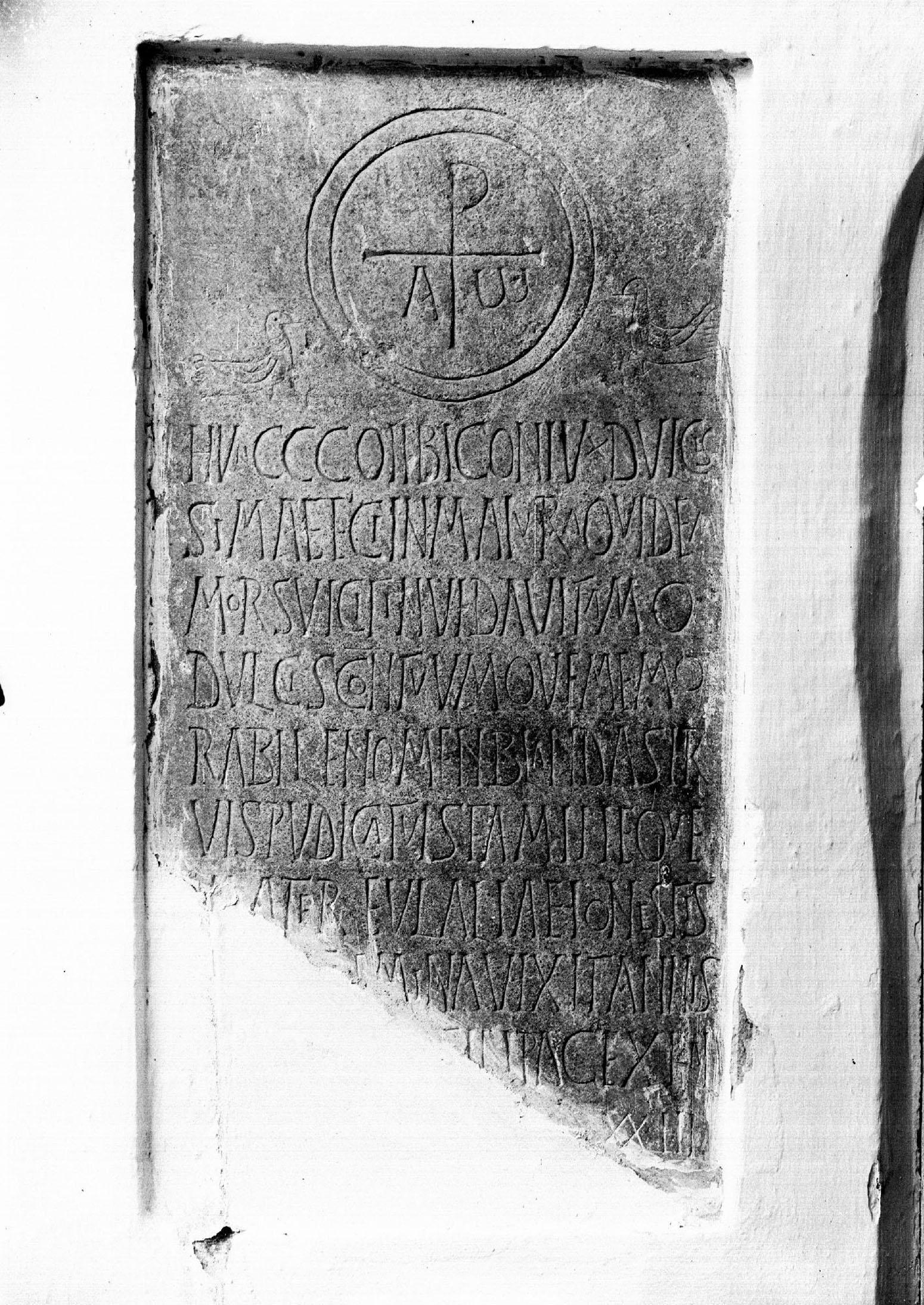Epitaph of Eulalia
Reference HEp 1997, 878 | Description | Lyrics | Location | Chronology | Epigraphic edition | Translation | Apparatus | Comentary | Type of verse | Text divided into verses and metric signs | Images | Bibliography | Link to DB | Author |
Epitaph of Eulalia
Description
- Idno filename 22/01/0022
- Type of inscription: Sepulcralis Christ.
- Support: Tablet
- Material: Granite Material Description: Grey colour.
- Conservation status: With a break in the lower left-hand corner.
- Dimensions height/width/depth (cm): 102/53/-
-
Epigraphic field:
- Layout: "Ordinatio" good. Letters carved with care, although some are larger than others; COLLANTES DE TERÁN took the measurements. Epigraphic field, 64.5.
- Decoration: The lower left-hand corner is preceded by a chrismon enclosed in a double circle with a dove at either side.
- Lost
Lyrics
- Font:Capital cuadrada
- Letter size:5 cm
Location
- Place of discovery: According to COLLANTES DE TERÁN, it was found in Olivares (Laelia, Sevilla), in the Caño de las Parras, at the beginning of the 20th century.
- Geolocation
- Conservation location: The only surviving photograph dates from 1953 and situates the piece in the Capilla de la Vera Cruz in Olivares (Sevilla).
- Location with Modern Nomenclature España / Sevilla / Olivares
- Location with Old Nomenclature Hispania / Baetica / Hispalensis / Laelia
Chronology
- Inscription's dating: Between year 470 and year 499
- Dating explanation:
In the last line the upper half of the snail-shaped
used for dating according to the Hispanic era can be made out, establishing the date of the inscription as 485 AD. This, then, is one of the first inscriptions dated according to the Hispanic era outside Mérida (for the Hispanic era, cf. VIVES 1938, AGUSTÍ - VOLTES - VIVES 1952, VIVES, ICERV, 177-185 and MOLERO 1999).
Type of verse
- Type of verse: Dactílico (hexámetro)
- Verse/line correspondence: No
- Prose/verse distinction: No
Epigraphic edition
⊂columba⊃ ⊂chrismo⊃ ⊂columba⊃
Hunc ˹eg˺o tibi coniux dulcis-
sima feci inmatura quidem
mors vicit invida vitam o
5 dulcis con(iux) tuumque memo-
rabile nomen blanda ser-
vis pudica tuis famili(a)eque
mater Eulalia honestis-
[sima] femina vixit annis
10 [-7?-]t in pace X Kal(endas)
[-6?- era] DXXIII
Text divided into verses and metric signs
Hunc ego tibi, coniux dulcissima, feci. lw|ww|l/l|l/l|lww|lx
inmatura quidem mors vicit invida vitam, ll|lww|l/l|lw|lww|lx
o dulcis con(iux), tuumque memorabile nomen: ll|ll|lwlwww|lww|lx
blanda servis, pudica tuis famili(a)eque mater.
Translation
"This (monument) I raised for you, dearest wife. Death, premature and envious, put an end to your life, oh sweet wife, and your memorable name. Good to your slaves, virtuous to your own and a mother to the household. Eulalia, most distinguished woman, lived… years (and rested) in peace ten days before the kalends of … (era) 523."
Bibliography
Papeles de Collantes De Terán (Dpto. Arqueología y Prehistoria, Universidad de Sevilla); González Fernández, CILA II, 1013 (HEp 1997, 878); Fernández Martínez – Carande, CLEB, SE12, cum del., quae in linguam Hispanicam verterunt (inde HEp 16, 2007, 533); Fernández Martínez 2008, 2383-2395, cum im. del.; Fernández Martínez 2010, 10; . Fernández Martínez, 2011, 270-272 cum im. phot. inedita (HEp 2011, 445). –cf. Gómez Pallarès 2007, 180-181, cum im del.
Apparatus
1 ECO COLLANTES TERÁN (qui litt. E formae uncialis intellexisse videtur), unde ego restituendum esse iam divinavit. – 7 eionestis Collantes De Terán. – 8 supplevit González Fernández 9 [—recessi]t González Fernández, sed item apti [requiesci]t aut [requievi]t.
Comentary
Funerary carmen in dactylic hexameters with irregularities, dedicated by the husband of the deceased. In l. 5, monophthongisation of ae in famili(a)eque, common at the time. The mors inmatura of Eulalia is lamented through a series of epigraphical topoi which are not exclusively Christian: only the decoration of the stone and the final formula attest its nature and chronology.
In l. 1, hunc -used as a noun- marks the inscription so that the passer-by will stop to read it (cf. CLE 761,10; 719,3, etc.); in ll. 2-3, the adjective dulcissima has many epigraphical parallels, cf. CLE 1429,1, as does inmatura -with etymological orthography-, cf. CLE 2179,5; 1260,3, etc. For the description of death as invida (l. 3), cf. CLE 1011,1; 1395B, 9, in a pessimistic vision apparently at odds with Christian beliefs. In l. 4 the adjective dulcis reappears, cf. Verg., Aen. 2,777. The preservation of memory through names (l. 4-5) is common in metrical epigraphy in Hispania (cf. Hernández Pérez 2001a, 115-118). For 4-5 memorabile nomen, cf. Ov., Met. 10,608 and Verg., Aen. 2,583; perhaps the expression here has a double meaning, given the popularity of saint Eulalia of Mérida. Followed by the female elogium, similar to others found in CLE 755,8 and especially 116d, 10. The name Eulalia (cf. Solin 1982, 710-711) is well documented in the Christian onomastics of the peninsula (cf. Vives, ICERV, 156, 306, 307b, 308b, 316, 328, 348), probably due to the cult of the female martyr from Mérida (cf. Salvador Ventura 1998, 77), which became widespread in Spain from the 4th c. on (DPAC 1991, s.v.7).
Author
- Author:C. Fernández Martínez, R. Carande Herrero
- Last Update2024-03-04 08:52:50
You can download this





